VF-1R "MUSTANG" VERITECH FIGHTER
(Version 1.02 - Last updated: 8/7/98)
- Concept and Background by Kenneth
Olson
- Background Information
derived from Robotech Technical
Files
- Original Design from Entertainment Bible 51: Macross II
BACKGROUND
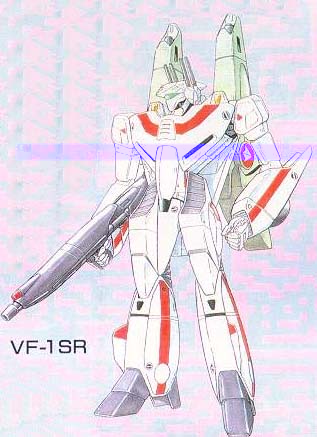 Once it became apparent that
the main transforming fighters for the Robotech Expeditionary Force (REF) was to be the
VAF-6 "Alpha" and the VBF-9 "Beta" fighters, veteran pilots from the
older Robotech Defense Forces (RDF) expressed their dissatisfaction. They felt that
with the proper upgrades the older VF-1 series of veritech fighters, could prove to be the
match of either of the newer designs. This opinion was no doubt influenced by the
fact that this pilots had supreme confidence in the older designs because they had
successfully defended the Earth during the First Robotech War with the VF-1.
However, in an effort to placate these veterans, which the REF would dearly need in the
upcoming campaigns, a new upgrade was created especially for the REF. The new design
was to be called the VF-1R "Mustang". The first production model the
VF-1SR was flown on July 17, 2018. Three slightly differing designs were created the
VF-1SR (with four head lasers), VF-1JR (with two head lasers), and the VF-1AR (with a
single head laser). Each model would be assigned, as with the older VF-1 series, by
rank.
Once it became apparent that
the main transforming fighters for the Robotech Expeditionary Force (REF) was to be the
VAF-6 "Alpha" and the VBF-9 "Beta" fighters, veteran pilots from the
older Robotech Defense Forces (RDF) expressed their dissatisfaction. They felt that
with the proper upgrades the older VF-1 series of veritech fighters, could prove to be the
match of either of the newer designs. This opinion was no doubt influenced by the
fact that this pilots had supreme confidence in the older designs because they had
successfully defended the Earth during the First Robotech War with the VF-1.
However, in an effort to placate these veterans, which the REF would dearly need in the
upcoming campaigns, a new upgrade was created especially for the REF. The new design
was to be called the VF-1R "Mustang". The first production model the
VF-1SR was flown on July 17, 2018. Three slightly differing designs were created the
VF-1SR (with four head lasers), VF-1JR (with two head lasers), and the VF-1AR (with a
single head laser). Each model would be assigned, as with the older VF-1 series, by
rank.
The basic airframe was kept, but the electronics, weapons and armor under went a major
overall. Two new Nakajima/P&W/Rolls-Royce FX-2010 fusion turbines were added to
replace the venerable FF-2001 or FF-2001D initially installed. These engines
produced 35% more thrust than the earlier models at three-quarters the weight. The
aging Hughes AWG-20 X-band pulse-Doppler radar was replaced with a new AWG-30 model
providing 50% greater detection range. The armor was upgraded to the Chobam laminar
found on the VBF-1 and VAF-6 series of veritech fighters.
The weapons compliment was changed. The VF-1R would replace the older GU-11
series of gun pods with the newer EP-5 particle gun. This newer gun is powered
directly by the protoculture generator and can fire single shots of 20 MJ. The two
head lasers were similarly upgraded to LA-3 lasers. The LA-3 are able to fire 4 MJ
bursts every 2 seconds. The hard points underneath each wing were kept the same.
However, a new FAST pack design the NP-BP-07 was mounted dorsally. The
NP-BP-07 mounted two EP-4's in the nose while keeping the 2 x HMMP-02 missile launchers.
In addition to the dorsal mounted FAST pack the VF-1R could mount any of the arm
and leg packs from the VF-1 series of veritechs.
The initial production run proved to be the only VF-1R's produced, although the
NP-BP-07 series of FAST packs proved to be incredibly successful and were in production
through the Third Invid War. Fifty VF-1RS's, 50 VF-1RJ's, and 10 VF-1RA's were
produced. To many this might seem odd that more of the officer versions were
produced than the standard 'A' type; however, one must take into account that most of the
veterans of the First Robotech War were officers and thus requested the 'S' model.
Unfortunately two events proved to be the death nail for the Mustang. First, the
design proved to be an excellent space superiority fighter and an adequate atmospheric
fighter. However, the VAF-6 series equaled or surpassed the new VF-1R in both
arenas. The second event was the design and production of the VF-1Y Kawamori. Upon recapture of Tyrol a new heavy
assault veritech, based on the venerable VF-1 and taking much from the VF-1R was designed.
Due to these two events only the initial production run was completed.
Roughly 70% of the total number of VF-1R went with the Robotech Expeditionary Forces into
deep space where it proved to be and excellent fighter against the Invid. The
remaining 30 or so VF-1R's were placed into front line squadrons against the Robotech
Masters. Although a majority of these fighters were destroyed during the Second
Robotech War, the VF-1R proved itself to be one of the premier transforming fighters.
Several VF-1R's are know to have survived the Invid Invasion and participated in
the final attack against Reflex Point.
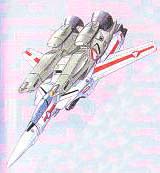
RPG STATS
- Vehicle Type: VF-1R "Mustang"
- Class: Variable Fighter
Manufacturer: Robotech Expeditionary Force
Crew: One pilot wearing Tactical Life Support System.
MDC BY LOCATION:
| Location |
Mustang |
| Head Lasers (1,2, or 4) |
25 |
| (1) Head |
90 |
| Hands (2) |
30 |
| Arms (2) |
150 |
| Right Mounted EP-5 |
90 |
| Legs/Engine Thrusters |
200 |
| Fast Packs (2) |
200 |
| (2) Main Body |
320 |
| Reinforced Pilots Compartment |
200 |
| Retractable Utility Arms |
3 |
| Wings (2) |
125 |
NOTES:
- Destroying the head of the Mustang will knock out the mecha's major sensor
systems, including all of the optics systems (infrared, nightvision, thermal). Radar and
communications will be unaffected.
- Depleting the MDC of the main body will destroy the mecha.
SPEEDS (Without FAST PACKS):
- RUNNING, SOLDIER CONFIGURATION:
- 90 kph
- LEAPING, SOLDIER CONFIGURATION:
- 50 ft (15 m) high or 70 ft (21 m) long without thrusters.
- FLYING, SOLDIER CONFIGURATION:
- 250 kph / 400 kph
- FLYING, GERWALK/SOLDIER CONFIGURATION:
- 400 kmph maximum speed limit in an Earth-like atmosphere. Can also hover in place
indefinitely.
- FLYING, FIGHTER CONFIGURATION:
- Max level speed at sea level : Mach 0.7
Max level speed at 10km: Mach 1.0
Max level speed at 30+ km: Mach 1.5
- Stall speed : 150 kph (VTOL rectification possible)
Service ceiling : 20 km (unboosted).
MAX ENGINE THRUST:
- Two Nakajima/P&W/Rolls-Royce FX-2010 fusion turbines, total engine
output 400 kN total at max. power; 715 kN are available with overboost. Exhaust nozzles
allow for vector thrust, serving in place of conventional elevators. System includes two
reverse-vernier thrusters, on blisters outboard of each intake; exhaust comes directly
from main turbine at a maximum of 20% thrust.
- TWO P&W GZ-2108 BOOSTER ENGINES IN THE FAST PACK: capable of
a total of 4000kN of thrust. Total propellant capacity 15,000 kg in FAST pack..
- Four Nakajima NBS-1 high-thrust vernier thrusters, four in the legs on
the ventral in fighter mode, two in the 'backpack' in Guardian and Battloid modes and four
on the two struts leading from the fast pack. Each thruster has a total engine
output of 10 kN.
STATISTICAL DATA:
- HEIGHT:
- 17.7m in soldier configuration.
- 12.3m in gerwalk configuration.
- 6.5m in fighter configuration.
- WIDTH:
- 10.1m at shoulders in soldier and gerwalk configuration.
- 14.8m with wings at maximum extension.
- LENGTH:
- 5.5m in soldier configuration.
- 12.3m in gerwalk configuration.
- 15.1m in fighter configuration.
- WEIGHT:
- 50,200 kg empty.
- PHYSICAL STRENGTH:
- Equal to a P.S. of 60
- CARGO:
- Small compartment behind pilot's seat for personal belongings in addition to the cyclone
storage compartment
- POWER PLANT:
- Two Tirolian mecha protoculture-generators ZT-5d providing a total of 1500 MW
- Delta V:
- 200 kps (with fast pack 100 kps without)
- COMPATIBLE FAST PACKS
(Macross Mecha Designs):
- Any of the following, however the two Dorsal mounted NP-BP-07 FAST packs are described
below.
- Dorsal: NP-BP-01, NP-BP-02, NR-BP-T1, NP-BP-10, NP-BP-11, NP-BP-12, NP-BP-19
Arm: NP-AR-01, NP-AU-T1
Leg: NP-FB-01, NP-FB-T1, NP-FB-10
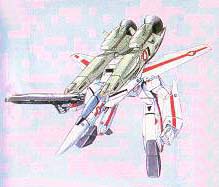
WEAPON SYSTEMS:
- EP-5 50MM SINGLE BARREL PARTICLE CANNON: The EP-5 is capable of firing 20 MJ
bursts up to 20 times per minute, with power coming directly from the main protoculture
generators. The EP-5 was meant to be a replacement for the aging GU-11 gun pod and as
such performed well. The EP-5 is an upgraded version of the EP-4 found on the VF-4
"Lightning". The gun is powered directly from the main protoculture
generators and as such the rate of fire is only limited by the recharge rate. The
weapon never became very popular because many pilots felt that the low rate of fire
did not offset the "effectively" unlimited ammunition supply.
- PRIMARY PURPOSE: Assault
- SECONDARY PURPOSE: Anti-Mecha
- RANGE: 2000 m
- DAMAGE: 2D4*10 per single shot
- RATE OF FIRE: Single shots equal to the combined attacks of the pilot up to 5
times per melee.
- PAYLOAD: Effectively unlimited
- LA-3 HEAD LASERS: The older Mauser RšV-20 laser cannons were upgraded to the
more powerful LA-3 laser cannons capable of firing 4 MJ shots every two seconds.
These weapons however were known to overheat if fired at maximum capacity for more than 30
seconds, as a result most mecha pilots only used them sparingly as a cutting tool or in
anti-missile defense.
- PRIMARY PURPOSE: Anti-missile
- SECONDARY PURPOSE: Assault
- RANGE: 600 m
- DAMAGE: 3d6 for each head lasers for a total of 3d6 for VF-1AR, 6d6 for VF-1JR,
or 12d6 for VF-1SR.
- RATE OF FIRE: Single shots equal to the combined attacks of the pilot up to eight
times per melee.
- PAYLOAD: Conditionally unlimited.
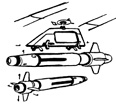
- BODY/WING HARD POINTS: Two fixed hard points are mounted on each wing.
These hardpoints can be used to carry 15 short range missiles, 5 medium range
missiles or 2
long range missiles.
- PRIMARY PURPOSE: Assault/Defense
- SECONDARY PURPOSE: Anti-Mecha
- RANGE: Varies with missile type
- DAMAGE: Varies with missile type
- RATE OF FIRE: In volleys of 1-5 for short and medium or in volleys of 1-2 for
long.
- PAYLOAD: 15 short range missiles, or 5 medium, or 2 long range missiles per
hardpoint
- (FAST PACK) 2 x EP-4 SINGLE-BARRELED PARTICLE CANNON: Two EP-4's are mounted in
the front of both of the FAST packs. The EP-4 is capable of firing 9 MJs of particle
energy every second and is powered by the aircraft's energizers. This gun is the same
as that used in the early models of VF-4 Lightning.
- PRIMARY PURPOSE: Assault
- SECONDARY PURPOSE: Anti-Mecha
- RANGE: 4000 feet (1200 m)
- DAMAGE: 1d4x10 for each single shot or 2d4*10 for dual shots
- RATE OF FIRE: Single shots equal to the combined attacks of the pilot
- PAYLOAD: Unlimited.
- (FAST PACK) 2 x HMMP-02 SHORT RANGE MISSILE LAUNCHERS: Each FAST pack has
two missile tubes per pack. Each launching tube has 8 missiles for a total of 16
short range missiles per FAST pack.
- PRIMARY PURPOSE: Assault
- SECONDARY PURPOSE: Anti-Mecha
- RANGE: Varies with missile type
- DAMAGE: Varies with missile type
- RATE OF FIRE: In volleys of 1, 2, 3 or 4.
- PAYLOAD: 16 short range missiles per launcher..
- HAND TO HAND COMBAT: If necessary, the Mustang can engage in melee combat rather
than use a weapon. The VF-1R is extremely agile and can execute most typical hand to
hand combat moves, such as punches, jump kicks, leap attacks, rolling with impacts, etc.
DAMAGE:
- Punch in Battloid: 3D6*3
- Punch in Guardian: 3D4*3
- Kick: 3D6*3
- Leap Kick: 6D6*3
- Body Flip/Throw: 3D6*3
- Body Block/Tackle: 3D6*3
- Stomp: 6D6*3 . (only effective against small objects)
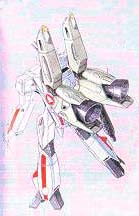
STANDARD EQUIPMENT FOR THE MUSTANG:
- AUTO-PILOT: The Mustang is equipped with a computerized auto-pilot, allowing the
pilot to relax or even sleep during long voyages. The auto- pilot can be programmed with a
single destination or a complex flight plan involving multiple speeds, directions, and
destinations. The onboard computer will alert the pilot when the fighter is near its
destination, and can also be set to automatically signal when sensors detect objects near
the mecha. The auto-pilot was designed with long intra-system space journeys in mind.
- TI-1000 COMBAT COMPUTER: The combat computer tracks and identifies specific enemy
targets, and has a database of over 10,000 images stored in memory. The computer can
identify and track up to 250 targets simultaneously.
- EXTERNAL AUDIO PICKUP: Range: 300 ft (91.5 m). A sound amplification system that
can pick up normal conversation up to 300 feet away.
- HEAT AND RADIATION SHIELDS: Special shielding prevents the penetration of life
threatening head and radiation. A radiation detection and alarm system are linked with the
shields and will sound an alarm if there is a rupture in the shields and what the levels
of radiation are.
- HOMING SIGNAL: The escape pod of the VF-1R is equipped with a homing device
that enables rescue teams to locate a disabled craft or ejected life pod. The range of the
signal is 400 miles (640 km). Most REF ships and veritecs can locate and track a homing
signal, and the onboard computers will automatically notify their pilots if such a signal
is detected.
- LASER TARGETING SYSTEM: Range: 100 miles (160 km). Used for increased accuracy in
the striking of enemy targets and is partly responsible for the mecha's strike bonus.
- LOUDSPEAKER: A loudspeaker system is built into the craft, which can be used to
amplify the pilot's voice up to 90 decibels.
- OPTICS: INFRARED: Range: 2000 feet (610 m). This optical system projects a beam
of infrared light that is invisible to the normal eye, but detectable by the mecha's
sensors. The system allows the pilot to detect hidden/concealed objects by their IR
reflectiveness. The beam will be visible to anyone with IR sensitive optics, however.
- OPTICS: NIGHTVISION: Range: 2000 feet (610 m). A passive light image intensifier
that emits no light of its own, but relies on ambient light which is electronically
amplified to produce a visible picture.
- OPTICS: THERMAL IMAGER: Range: 2000 feet (610 m). A passive optical heat sensor
that detects infrared radiation projected by warm objects and converts that data into a
false-color visible image. The system enables the pilot to see in the dark, in shadows,
and through smoke, and also adds a +10% bonus to pilots using a tracking skill.
- HUGHES AWG-30 RADAR: 200 mile range.
- RADIO/VIDEO COMMUNICATION: Long range, directional communications system with
satellite relay capabilities. Range: 600 miles (960 km) or can be boosted indefinitely via
satellite relay.
- SELF-DESTRUCT: To prevent capture of an advance variable fighter by the enemy,
the pilot can activate the VF-1R self-destruct system, which will cause the fighter
to explode after a delay of up to 60 minutes (time is set by the pilot). The explosive
damage is contained within a 20 foot (6 m) area and inflicts 1D6x10 M.D. to everything
within the radius of the explosion. All internal systems are obliterated. The escape pod
will be automatically ejected prior to the explosion unless the pilot overrides the
ejection sequence.
- STANDARD SURVIVAL KIT: All REFs veritechs come equipped with a portable survival
kit. Inside the small reinforced box is a medium-sized flashlight, two hand flares, one
rocket flare, a compass, infrared distancing binoculars, a small mirror, a pocket knife,
dehydrated and concentrated food (can be stretched into a five day supply for one person)
and basic first aid items (aspirin, bandages, disinfectants, etc.)
- TACTICAL LIFE SUPPORT SYSTEM: The Mustang's cockpit is pressurized, and also
provides additional air feeds to the pilot's flight suit that provides him with
pressurized breathing. The REF flight suit also contains an upper and lower g-suit that
promotes blood circulation even during high-g turns, thus decreasing the possibility of
pilot's blacking out in combat.
- Elettronica Radar Warning Receiver (RWR)
- OlDelft Infra-red Warning Receiver (IRWR)
- Westinghouse ALQ-250(V) active sensor jammer
- Chaff and Flare dispensers: 12 chaff and 12 flares are stored in each
lower leg
COMBAT BONUSES FOR MUSTANG TRAINING:
- 3 attacks per melee (plus those of the pilot).
- Add one additional action/attack at levels six and eleven.
- +2 to strike
- +2 to parry
- +2 to dodge in solder, +4 in guardian, and +6 in jet mode.
- +3 to roll with a punch or fall with an impact, reducing damage by half.
- Critical strike same as pilot's hand-to-hand.
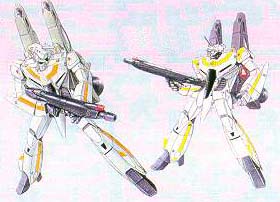
REFERENCES USED IN THIS DESIGN
- Robotech Technical Files: Veritech Valkyrie
- Palladium Books: "Robotech The Roll Playing Game"
- Entertainment Bible 51: Macross II
Back to Mecha Home
 Once it became apparent that
the main transforming fighters for the Robotech Expeditionary Force (REF) was to be the
VAF-6 "Alpha" and the VBF-9 "Beta" fighters, veteran pilots from the
older Robotech Defense Forces (RDF) expressed their dissatisfaction. They felt that
with the proper upgrades the older VF-1 series of veritech fighters, could prove to be the
match of either of the newer designs. This opinion was no doubt influenced by the
fact that this pilots had supreme confidence in the older designs because they had
successfully defended the Earth during the First Robotech War with the VF-1.
However, in an effort to placate these veterans, which the REF would dearly need in the
upcoming campaigns, a new upgrade was created especially for the REF. The new design
was to be called the VF-1R "Mustang". The first production model the
VF-1SR was flown on July 17, 2018. Three slightly differing designs were created the
VF-1SR (with four head lasers), VF-1JR (with two head lasers), and the VF-1AR (with a
single head laser). Each model would be assigned, as with the older VF-1 series, by
rank.
Once it became apparent that
the main transforming fighters for the Robotech Expeditionary Force (REF) was to be the
VAF-6 "Alpha" and the VBF-9 "Beta" fighters, veteran pilots from the
older Robotech Defense Forces (RDF) expressed their dissatisfaction. They felt that
with the proper upgrades the older VF-1 series of veritech fighters, could prove to be the
match of either of the newer designs. This opinion was no doubt influenced by the
fact that this pilots had supreme confidence in the older designs because they had
successfully defended the Earth during the First Robotech War with the VF-1.
However, in an effort to placate these veterans, which the REF would dearly need in the
upcoming campaigns, a new upgrade was created especially for the REF. The new design
was to be called the VF-1R "Mustang". The first production model the
VF-1SR was flown on July 17, 2018. Three slightly differing designs were created the
VF-1SR (with four head lasers), VF-1JR (with two head lasers), and the VF-1AR (with a
single head laser). Each model would be assigned, as with the older VF-1 series, by
rank.



